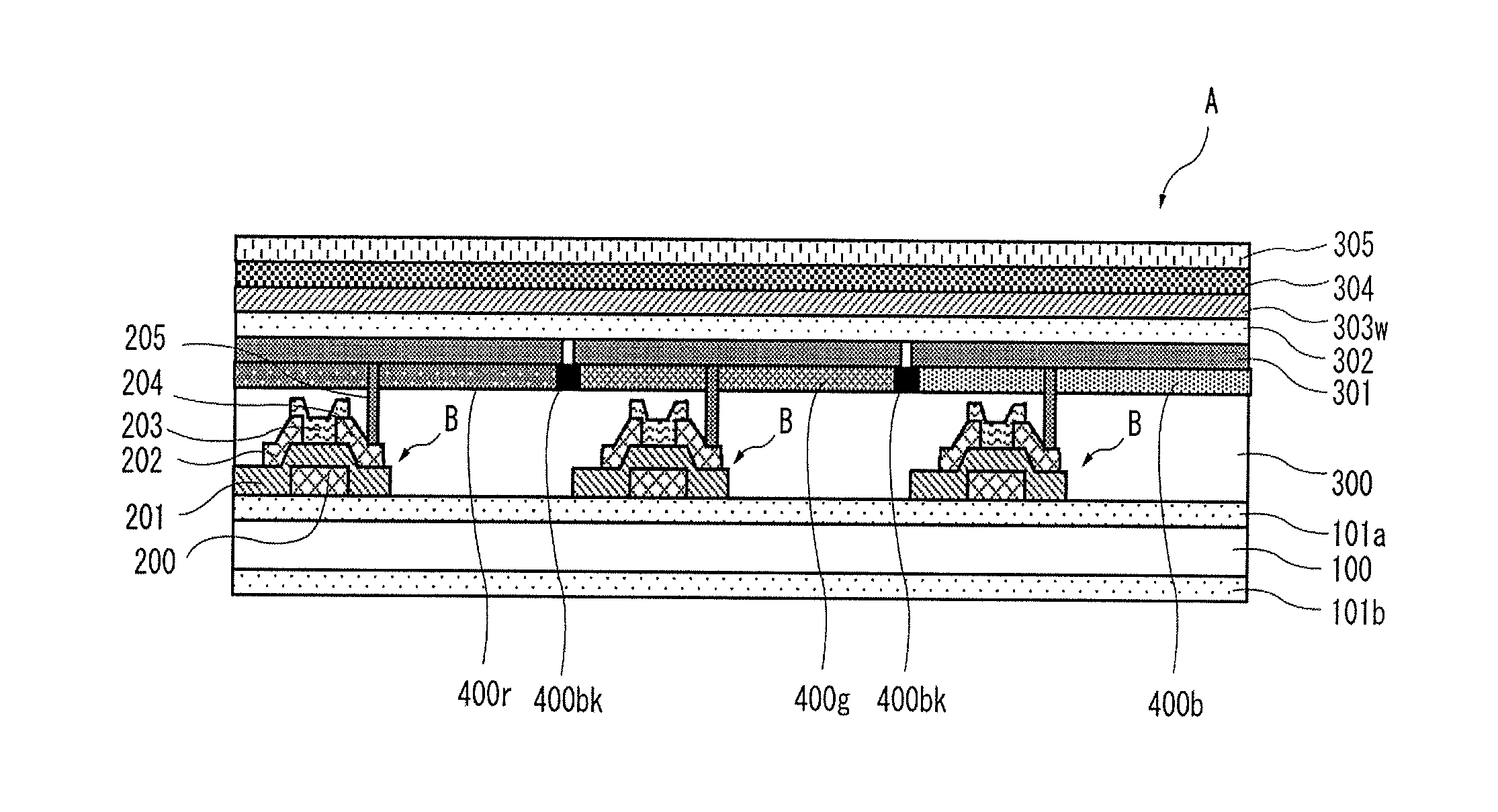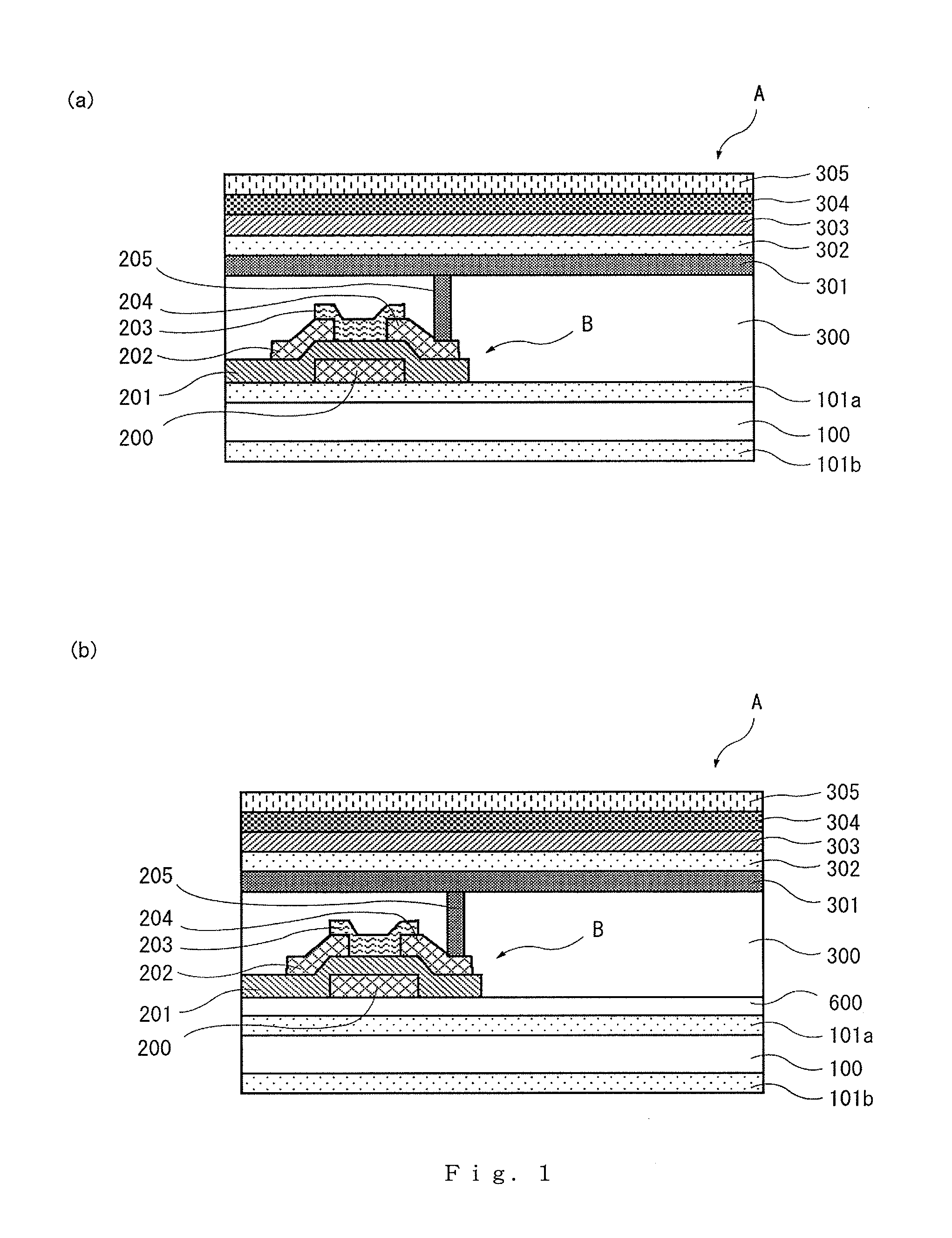Organic el display and method of manufacturing organic el display
a technology of organic el and display, which is applied in the direction of sustainable manufacturing/processing, final product manufacturing, thermoelectric devices, etc., can solve the problems of high luminance, high speed responsibility, and inability to obtain high luminan
- Summary
- Abstract
- Description
- Claims
- Application Information
AI Technical Summary
Benefits of technology
Problems solved by technology
Method used
Image
Examples
first embodiment
[0093]FIG. 5 is a process flowchart illustrating a method of manufacturing an organic EL display. The method according to the embodiment includes a gas barrier layer forming process S1, a thin film transistor forming process S2, and organic EL device portion forming process S3. In the gas barrier layer forming process S1, gas barrier layers 101a and 101b are formed on a transparent plastic substrate 100 which has a shape of a long roll.
[0094]In the thin film transistor forming process S2, an active layer 203 containing a non-metallic element which is a mixture of oxygen (O) and nitrogen (N) and has a ratio of N to O (N number density / O number density) from 0 to 2 is formed on the gas barrier layer 101a through a sputtering method.
[0095]In the organic EL device portion forming process S3, a lower electrode 301 which is a positive electrode of the organic EL device A, a hole transport layer 302, a light emitting layer 303, an electron transport layer 304, and an upper electrode 305 wh...
second embodiment
[0126]Although the configuration of the second embodiment is similar to that of the first embodiment, the organic EL device portion forming process S3 includes a process of forming layers of emitting light of at least three primary colors of red (R), green (G), and blue (B) in the organic EL device A. In the case where full-color display is performed by an organic EL display C, a configuration for emitting light of at least three primary colors of red (R), green (G), and blue (B) is needed. In this case, since the emitted light of the organic EL device A is directly used as it is, the light use efficiency is the highest among full-color display methods, which is preferable. A configuration for emitting light of four colors or six colors including white (W), yellow (Y), cyan (C), and the like in addition to RGB may be used.
third embodiment
[0127]Although the configuration of the third embodiment is similar to that of the first embodiment, the organic EL device portion forming process S3 includes a process of forming at least a white light emitting layer and a color filter layer in the organic EL device A. Instead of emitting light of three primary colors or light of four colors to six colors, full color display can be made by using a white light emitting layer and a color filter layer. In this case, since only a single white light emitting layer may be formed as the light emitting layer, there is no need to form separate light emitting layers for different colors of the emitted light. Therefore, the number of processes can be reduced, and the manufacturing apparatus is more simplified, so that it is effective in that the manufacturing can be performed with a more inexpensive apparatus. Similarly to a color liquid crystal panel, the full color display is performed by allowing the light from the white light emitting lay...
PUM
 Login to View More
Login to View More Abstract
Description
Claims
Application Information
 Login to View More
Login to View More - R&D
- Intellectual Property
- Life Sciences
- Materials
- Tech Scout
- Unparalleled Data Quality
- Higher Quality Content
- 60% Fewer Hallucinations
Browse by: Latest US Patents, China's latest patents, Technical Efficacy Thesaurus, Application Domain, Technology Topic, Popular Technical Reports.
© 2025 PatSnap. All rights reserved.Legal|Privacy policy|Modern Slavery Act Transparency Statement|Sitemap|About US| Contact US: help@patsnap.com



